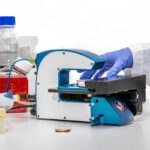
Cell Counter
Your automatic cell counter

The HoloMonitor® cell counter is designed for automated cell counting of suspension cells. It offers a no-hassle, high-precision automatic cell counter with results presented within a minute. Count live and/or dead cells in your cell culture and can be used not only for seeding but also for end-point cell counting of suspension cells.
Benefits
Why choose the HoloMonitor Cell Counter?
Assay Output
What results do you get with this cell counting system?
The HoloMonitor Cell Counter is designed for automated cell counting of suspension cells. It can be used in two ways, either to count cells as a preparation for seeding, or for endpoint cell counting of suspension cells where data of cell volume and area is acquired.
When used for seeding, a dilution calculator can provide the volume needed for sampling. When used as endpoint cell counter, the created distribution graphs based on cell volume and area are provided. Certainly, our App Suite software provides the opportunity to export all data as Excel files (.xlsx) for further analysis.
Endpoint data are given per well:
- Cell count (cells/ml)
- Mean cell volume (µm3)
- Mean cell area (µm2)
- Distribution graphs on cell area and volume


Do you want to count adherent cells as well?

Reliable.
Quick and accurate cell count in one minute
Cell counting is a routine task for any researcher working with cells, but counting cells manually with conventional hemocytometers is tedious. It is not only time-consuming but also requires scrutiny. However, obtaining accurate cell counts is important for both cell expansion and for accurate and repetitive results for cell-based assays. Besides, HoloMonitor auto-focus leads to highly reproducible cell counts with reduced user-to-user variability compared to a hemocytometer and cell counters with manual focus.
Key Applications
What can you study with this automatic cell counter?
Cell QC
Suspension cell morphology
Cell expansion
Cell seeding

Automatic.
Minimized the workload for you
Undoubtedly, automated cell counting can certainly speed up your workflow and eliminate user-to-user differences. The HoloMonitor Cell Counter is designed to count suspension cells using a non-grid counting chamber automatically. Cell count is provided in a number of cells per volume unit, i.e., the same principle as with Bürker chamber cell counting. In addition, a dilution calculator tool will automatically provide the stock suspension volume needed for seeding the cells in the upcoming experiment or next passage.
Cell Counter Protocol
How do you set up this cell counter?

1. Sample preparation
Simply add cell suspension to the counting chamber. Then, slide the counting chamber into the vessel holder onto the HoloMonitor stage.

2. Assay setup
Select Cell Counter and follow the guided setup. Next, select your imaging positions. Start imaging and walk away!

3. Explore results
Review results determined automatically by the software, and re-analyze the data if you want.

Efficient.
Much more than just a cell counting system
Many experiments today require not only cell count numbers but also several key cell features. HoloMonitor Cell Counter, on the other hand, provides much more than just cell count. We also provide information and graphs showing basic cell morphology are part of the automatic result presentation in the cell counter assay such as cell diameter and volume and provide distribution graphs based on these parameters.

The live cell imaging method not only saves time and labor, but also provides more accurate and detailed information.
Huang J, GUO P & MOSES M
Boston children’s hospital
Featured Publications
Browse our publication library for more references and see how our worldwide HoloMonitor customers use this cell counting system.

Propofol prevents oxidative stress and apoptosis by regulating iron homeostasis and targeting JAK/STAT3 signaling in SH-SY5Y cells
Journal: Brain Research Bulletin (2019)
Research Areas: Neuroscience
Cell Lines: SH-SY5Y
Lipopolysaccharide promoted proliferation and adipogenesis of preadipocytes through JAK/STAT and AMPK-regulated cPLA2 expression
Journal: International Journal of Medical Sciences (2019)
Research Areas: Cell research, Inflammation
Cell Lines: 3T3-L1

Translational medicine in pulmonary-tenal crosstalk: Therapeutic targeting of p-cresyl sulfate triggered nonspecific ROS and chemoattractants in dyspneic patients with uremic lung injury
Journal: J. Clin. Med. (2018)
Research Areas: Cancer research
Cell Lines: A549

CAT3, a prodrug of 13a(S)-3-hydroxyl-6,7-dimethoxyphenanthro[9,10-b]-indolizidine, circumvents temozolomide-resistant glioblastoma via the Hedgehog signaling pathway, independently of O6-methylguanine DNA methyltransferase expression
Journal: OncoTargets and Therapy (2018)
Research Areas: Cancer research
Cell Lines: U251/TMZ and T98G